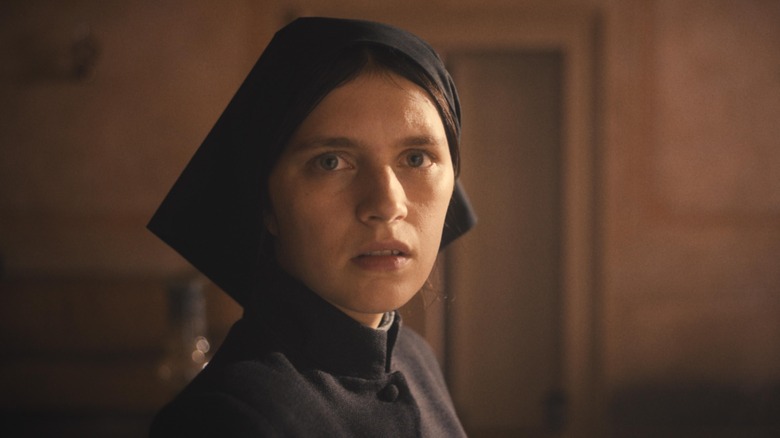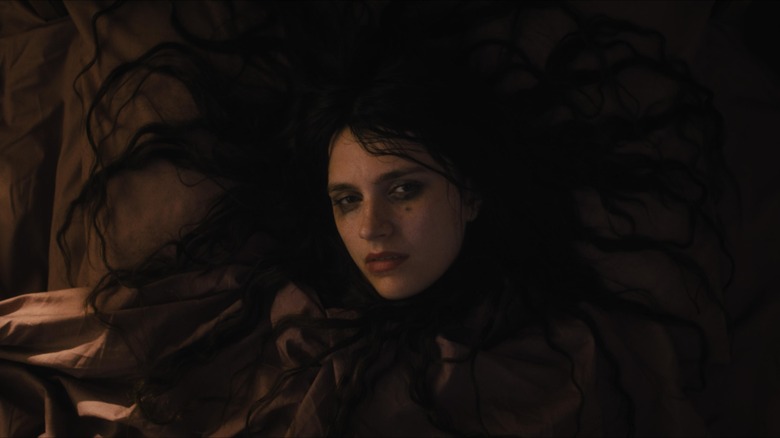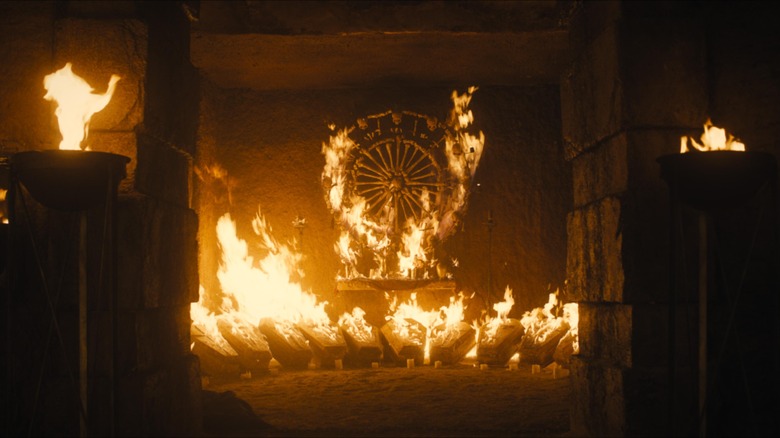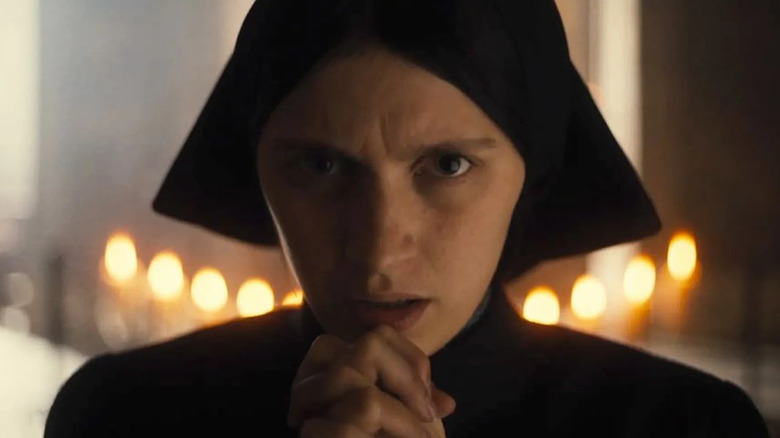The First Omen Review: A Terrifying Horror Prequel Done Right
When compared to "classier" Satanic contemporaries like "Rosemary's Baby" and "The Exorcist," Richard Donner's 1976 hit "The Omen" is the pulpiest of the lot. "The Omen" had no interest in the sexist panic of the former, nor the religious angst of the latter, settling instead in the realm of spooky thrillers, replete with cool kills, portentous Satanic language, and an awesome score (a score that brought Jerry Goldsmith his only Oscar). There's no ambiguity to "The Omen," being clear from the start that Gregory Peck and Lee Remick are indeed raising the Antichrist. The pop Satanism "The Omen" introduced into the lexicon has now become standard horror fare, and was even spoofed at length in the TV series "Good Omens."
"The Omen" spawned one okay sequel ("Damien: Omen II" in 1978), one risibly bad sequel ("The Final Conflict" in 1981), and one miserably bad sequel ("Omen IV: The Awakening" in 1991) before succumbing to the remake trend in 2006. Deep-cut horror fans may also know about "The Omen" TV series in 1991 and the "Damien" TV series from 2016, but neither of those is very good either. By 2024, the time seemed right to milk "The Omen" for a few more drops of dwindling nutrition before being put out to pasture.
Imagine the shock, then, to learn that Arkasha Stevenson's prequel film "The First Omen" is, without qualification, quite excellent. In an age when long-in-the-tooth horror franchises like "Halloween" and "The Exorcist" are being tiresomely revived without a trace of creativity, it's refreshing and splendid to see a picture that is thoughtfully menacing, uniquely stylish, deathfully intense, and utterly terrifying. "The First Omen" is a film of dank, bloody, spittle-flecked dread, made no less powerful by the foregone conclusion.
Woe to you, oh earth and sea, For the Devil sends the beast with wrath
If one recalls their "Omen" lore, one might remember that Lee Remick's character from Donner's original was hoodwinked at the hospital and had her baby swapped out for Damien, the Antichrist child provided by a mysterious sect of Satanic nuns. Damien was planted with Remick because her husband, the Gregory Peck character, was a powerful ambassador, and the Antichrist could do a lot more damage with political connections. Damien, it is explained, was actually the product of a human woman and a demonic Jackal.
"The First Omen" is the story of that human woman, told from the perspective of Sister Margaret (Nell Tiger Free). Margaret is an American novice staying in a Catholic orphanage in Rome. She is on the cusp of reciting her vows and being inducted into the church but finds herself struggling with a new bout of hallucinations, an affliction she has suffered since childhood. She has a sassy roommate, Luz, (Maria Caballero) who encourages her to have a few sneaky nights on the town drinking and making out with strangers before she leaves the secular world for good.
Floating through the periphery are a bevy of terrifying nuns, each one with a more expressive face than the next. Casting is a large part of the effectiveness of "The First Omen" and I found myself wondering where Stevenson found some of the gnashing, gaunt nun performers. Overlooking them all is the long-faced Abbas (Sônia Braga) and an itinerant Cardinal (Bill Nighy). Margaret can't explain why, but the entire orphanage seems to be putting undue pressure on the orphan Carlita (Nicole Serace), a mentally ill teen the nuns regularly lock in her room.
Because he knows the time is short, Let him who hath understanding reckon the number of the beast
Margaret is also hounded by a local priest (Ralph Ineson) who seems to know about a strange conspiracy in the Catholic church. He'll eventually implore her to steal some file folders from the orphanage as proof of said conspiracy. Without revealing anything, I will say that the ultimate scheme being enacted by the film's bad guys is weirdly salient in 2024. In an age where young people are fleeing Christianity in droves, the villains' concerns seem legitimate.
The story of "The First Omen" bears many similarities to Michael Mohan's thriller "Immaculate," which was released in theaters less than a month ago. Both films are about put-upon young nuns in labyrinthine Italian nunneries, teetering on the cusp of holiness but staring deep into an infant-based wash of demonic horror. Both films also feature scenes of the protagonists peering through a cracked door to witness acts of violence or pain, only to be interrupted by a grumpy Mother Superior.
But whereas "Immaculate" was neither powerfully stylized nor pleasantly sleazy, "The First Omen" is made by a filmmaker with visual assurance, thoughtfulness, and an ear for horror. Stevenson is making her feature directorial debut, but her aesthetic assurance bears the confidence of an old pro. She has a knack for drum-tight editing, eerie, groaning sound effects, and hiding creatures in the dark. A nightmare sequence sees a character floating gently down a hallway, and it's as indelible an image as one might find in modern horror. There is an insane propulsiveness to "The First Omen," an insanity that grows over its first 90 minutes. Stevenson is not merely constructing jumpscares as a lesser filmmaker might, but paying close attention to the slow burn. Everything progresses with sickening efficiency.
For it is a human number, Its number is six hundred and sixty-six
Modern audiences have been milked for their nostalgia juices so often, that tiresome callbacks and lazy references to 40-year-old movies have become our bland bread and butter. Watch one of the last two "Ghostbusters" movies, and marvel at how often they repeat old lines of dialogue or allow the camera to linger near-sexually over a dusty prop.
"The First Omen" doesn't fully escape the trap of the reference. A notable line of dialogue from Donner's "The Omen" is repeated during a key moment, as is one of the original film's more notorious deaths. Of course, the filmmakers thought to include "Ave Satani," Goldsmith's famed Satanic Hymn from the 1976 film. And naturally, "The First Omen" will directly link to the first "Omen." It's during these weary obligations that Stevenson's film feels weakest; although beloved, no one is so fond of "The Omen" that we need direct callbacks and specific dialogue to keep us interested.
For the most part, Stevenson eschews nostalgia in favor of — imagine that! — actual horror. "The First Omen" is pungent, dripping with fluids, and featuring a few startling rounds of gnarly violence. Demon hands emerge from places they should not, and a woman's bodies are aggressively mutilated by a series of scalpels and needles designed to keep her in her place.
Naturally, "The First Omen" is a tale of Catholic control of women's bodies, of how piety and humanity are exploited for the benefit of ancient organizations that have lost their humanity in their centuries of service. Bleak, severe, and awesome, "The First Omen" is the best horror movie of the year so far.
/Film rating 8.5 out of 10



